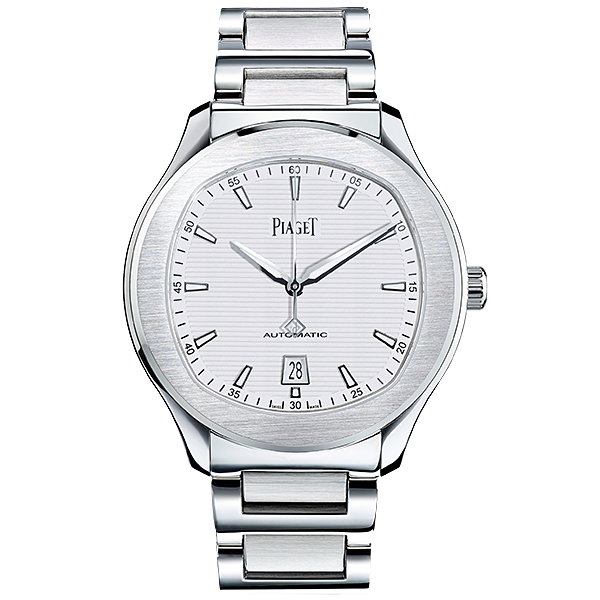Brands turn to steel for entry-level watches

Roula Khalaf, Editor of the FT, selects her favourite stories in this weekly newsletter.
While watch sales across the industry fall precipitously, down 14 per cent year-on-year to July, exclusive brands are trying to arrest the drop by introducing new “entry-level” models made of steel. Companies including Piaget, Vacheron Constantin, Blancpain and Chopard are now producing steel watches at lower price points, aping a strategy adopted previously by Montblanc, Jaeger-LeCoultre and Zenith.
Along with factors such as falling oil prices, China’s anti-corruption campaign and the strong Swiss franc, above-inflation price hikes of the last decade are also proving painful. The average price of a Swiss watch rose by 53 per cent between 2005 and 2015, according to the Federation of the Swiss Watch Industry (FHS); inflation in Hong Kong, the watch industry’s second biggest export market, rose by 39 per cent over the same period. There are no signs that the growth in demand which swelled Swiss watch exports from SFr10.3bn ($10.5bn) in 2000 to SFr22.3bn in 2014 will return.
Piaget’s response to this decline is the Polo S, launched in July. The collection, which is backed by a multi-million-dollar marketing campaign fronted by Hollywood stars Ryan Reynolds and Michael B Jordan, is the first in steel Piaget has introduced since 2001.
“It’s a watch for a new generation of consumers,” says Philippe Léopold-Metzger, Piaget’s chief executive. “Sometimes prices got out of hand — you need to offer value for money.”
Not that value for money guarantees immunity from the downturn. “The pain is much deeper than people thought,” says Peter Stas, chief executive of Frédérique Constant, a brand that specialises in accessible luxury watches and that had enjoyed consecutive years of growth since it was founded in 1988, according to Mr Stas.
“We have a more accessible luxury positioning, which typically does much better in this kind of climate, compared to higher-end watches,” he says, “but we are down by 8 per cent this year, and expect to produce 140,000 watches against a budget of 150,000.” Frédérique Constant was acquired by the Citizen watch group in May this year.
Mr Stas is critical of the industry’s larger groups, which he believes have exacerbated problems that could have been avoided with a more prudent approach. “Specialist groups with their pressure from the stock exchange have been pumping the market too full of products, despite knowing that heavy weather was coming,” he says. FHS figures show that watch exports by unit have hovered between 28m and 29m since 2013.
Part of Mr Stas’s solution is the steel Slimline Perpetual Calendar, launched at the Baselworld trade fair, which he hopes will contribute to a change in fortunes for his brand. At £7,200 and with an in-house movement, it costs 15 per cent less than the nearest competitor with the same complication, a steel watch produced by Montblanc. He says the brand has already sold 1,200 pieces, above its expectation of 500.
Retailers have welcomed the more affordable proposition. “There was a bubble created by the explosive growth of Chinese consumers in Hong Kong and mainland China,” says Brian Duffy, chief executive of Aurum Group, the UK’s largest watch retailer and parent company of Watches of Switzerland and Mappin & Webb. “The industry now has to look to other avenues for growth. That’s very healthy because we’re getting more consideration of value and more consideration of technical and aesthetic development. The consumer is much better off from this because they’re getting fantastic products at prices that make sense.”
Mr Duffy points to improvements made by Rolex. In July 2015, the brand announced that all new watches coming out of its Swiss factories would carry five-year warranties and recommended service intervals of 10 years, a new industry benchmark. “Rolex has introduced far greater performance without any greater cost to the consumer,” he says.
Some brands adopted a more affordable stance before the storm hit. Three years ago, Montblanc introduced a strategy its executive vice-president Jens Henning-Koch calls “sharing a passion for fine watchmaking”.
“When you look at the market there has been a steady price increase over many years,” says Mr Henning-Koch. “We were convinced we could create great value in the €2,000-€5,000 segment. Developments since then prove that was not a bad move.” Montblanc is part of the Richemont group, which does not publish individual brand performance, but Mr Henning-Koch says the strategy has been “well perceived” and that it is “the right strategy for the time”.
Historically, steel has appealed to traditional markets such as the US and western Europe, in particular for sports watches. Mr Duffy believes the industry will now turn its focus back west after a period of reliance on growth in the east. “There’s no doubt that the Asian consumer was spending at a higher level and was disproportionately interested in precious metals, diamonds and high-end complications. That was distorting the global market,” he says. “It’s the move east to west that’s now creating the overall global trend. I’ve no doubt the Swiss watch industry will get out of the current rut — we’re in the depths of it at the moment.”
Mr Stas is not so sure. “Across the industry, we are looking at a 12 to 15 per cent downcycle for the first half of this year and, frankly, I don’t think it’s the end of it. It’s going to be a tough year.”
Steel yourself: big brands’ more affordable pieces
Piaget Polo S

Piaget’s first steel watch in 15 years picks up on a 1970s-inspired trend; is water-resistant to 100m; and has an in-house movement with a 50-hour power reserve. £7,850
Vacheron Constantin Quai de l’Ile
The Quai de l’Ile isn’t new, but this year’s steel additions are, and they bring the access point into the collection down by £15,000. Being a Vacheron, they carry the prestigious Hallmark of Geneva stamp. £11,700
Jaeger-LeCoultre Reverso One Réédition
Jaeger-LeCoultre has made cornering the female market a pillar of its growth strategy. This steel-cased, quartz-powered version of its reversible watch continues the theme. £3,700
Frédérique Constant Slimline Perpetual Calendar

Designed from the ground up in the Geneva manufacture, this year’s Slimline sets a low-price benchmark for mechanical perpetual calendars. £7,200
Rolex Air-King

Rolex now gives all of its new watches a five-year warranty and recommends previously unheard-of service intervals of 10 years. Demand for this year’s steel Air-King is said to be sky-high. £4,150
Comments